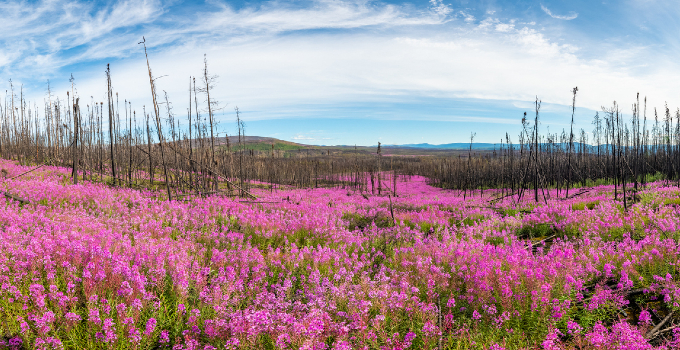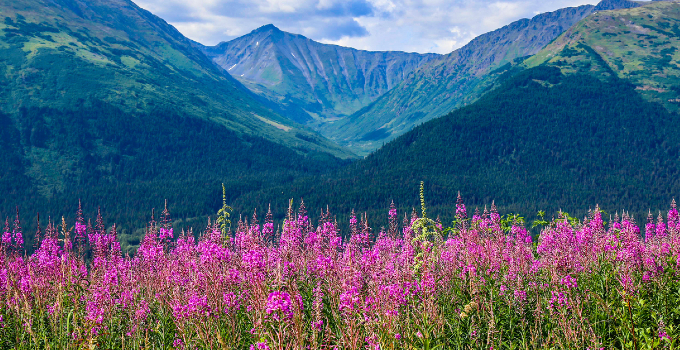Fireweed is a healer of burns, most importantly, when wildfires have harmed our precious forests. Whenever fire has devastated a boreal forest, this wild plant starts to grow and soon after, the beautiful magenta blooms appear, and the healing process prepares the soil for willow and poplar to follow.
While its seeds are prolific, its roots are what really earns fireweed its weed status. Every plant sends out a massive network of rhizomes and only the tiniest portion can readily create another plant. The roots are tough enough to survive the intense heat from a forest fire. As soon as the soil cools down, the roots are busy recolonizing the parched earth. The roots create a perfect underground mat that helps stabilize the soil and reduces erosion following a fire.
The common name fireweed is perhaps derived from the German Feuerkraut, the name given by Gesner in 1561, for a plant that flourishes on grounds destroyed by fire. In England, the common name Bombweed was given for the quick manner of its colonization of bombsites. Fireweed was one of the first plants to appear after the eruption of Mt. St. Helens in 1980. This remarkable plant can produce up to 45,000 seeds.
Historically, fireweed was important to native people around the world. Tea was and continues to be made from the leaves. High in vitamins A and C, fireweed shoots provided a tasty spring vegetable which is still enjoyed today. Flowers yield copious nectar that yields a rich, spicy honey that is second-to-none. Today, fireweed honey, jelly, and syrup are popular wherever this species grows in abundance, especially Alaska.
According to the Manitoba government website: “The North American First Nations people used fireweed as a fresh or cooked vegetable, as a tobacco substitute, and as a poultice to draw out infections. Stem fibres were used for thread. Today fireweed has been shown to have potent anti-inflammatory activity and is being developed into products to treat skin problems such as diaper rash, and as a mouthwash for the treatment of sore gums. The nectar is also important in the honey business.”
Fireweed is usually found in dry, open disturbed areas making this a beautiful addition to the home garden. It reproduces readily from rhizomes as well as from seed, so if left unattended, it can quickly take over a garden.
Fireweed as Food
From root to flower, all parts of the fireweed plant can be used as a food source. Roots and early shoots can be harvested and eaten in the spring. In the summer, leaves can be gathered and eaten fresh among salads and stir fries, or dried and used as tea. Fireweed flowers add a brilliant color to summer salads or can be cooked down with sugar, water, and pectin to make a pink fireweed jelly.
In spring, when fireweed emerges from the ground, its shoots are edible and is somewhat like wild asparagus. As it grows, fireweed stalks remain edible but become quite bitter. The larger the shoots and the more developed the leaves, the more bitter they taste. The sweetest fireweed shoots are those cut when the leaves are still reddish. Larger stalks can be split, and the inner pith scraped out and eaten as a sweet treat.
Fireweed shoots are a nutritious spring food containing Vitamin C, flavonoids, and beta-carotene. It also contains trace elements of iron, copper, nickel, potassium, and calcium. They are delicious when eaten fresh or steamed. Shoots can be chopped and used in a salad or sautéed in olive oil, sprinkled with sea salt.
Young leaves can be pinched off and consumed like spinach. Larger stalks can be split, and inner pith scraped out and eaten as a sweet treat. This is high in mucilage and has been used as a thickener for soups.
Historical Uses
Fireweed has a long history of uses throughout North America and in other locations throughout the northern hemisphere. The following is a brief overview of some of the uses:
In their book, Gwich’in Ethnobotany, Andre and Fehr reported that Gwich’in people knew that the whole plant can be boiled as a medicine and the liquid rubbed on the skin for rashes. A poultice was made from the leaves and applied to burns, bee stings, aches, and swelling caused by arthritis.
The Cree call it Ihkapaskwa. The root was macerated and applied to boils or infections. The leaves were plastered on bruises.
The Kamtschadalis of eastern Russia scraped out the pith with shells, tied it in bundles and sun-dried it. This was known as Kipri. They used Kipri to make Quaffe, a fermented beverage of malted rye, flour, and wild mint.
The Woods Cree of Saskatchewan made a tea of the whole plant for intestinal parasites. The root was crushed and applied to boils or abscesses, or to draw out infection from open wounds.
Blackfoot rubbed fireweed flowers on their mittens and rawhide thongs as waterproofing. The inner pith from the stems was dried, powdered and rubbed on their hands and face to protect the skin from winter’s bitter cold.
The Ojibwa call it Zhoshkidjeebik or Oja’cid’bik meaning slippery root. Roots would be moistened and pounded until lathered up and applied it as a poultice to bruises, boils, and sores.
Sophie Thomas, a Sai’Kuz elder and herbalist, suggests drying the root and then cooking it to treat asthma.
Alaskan Natives used fireweed tea for stomach aches. Tea made using the leaves is considered stronger than chamomile tea. Dried fireweed roots (gathered after the plant has dried) was mixed with grease and spread on infected sores or bites.
The Cheyenne made a tea from either from the dried and pulverized leaves (less potent) or roots (more potent) to help with rectal hemorrhage.
If you haven’t had the opportunity to experience the incredible values that fireweed possesses, try growing it! If this isn’t possible, be sure to seek out a credible online source of herbs and other fireweed products. If honey is what you seek, be sure to check out The Alaska Frontier.
Sources:
MINI REVIEW Fireweed – A treasured medicine of the boreal forest. Robert D Rogers
Native American Ethnobotany: Moerman, Daniel E






A super blog – thank you!!
Not too little info but not too much; just right! Luv fireweed!!!
Gorgeous flower the fireweed!!! Anyone who sees this in its full bloom is so fortunate. Great info thanks for writing this!!!!!
This is outstanding information. THANK YOU
Thank you for reading!!!
Brilliant – love this. Well written and makes you want to go somewhere where there are tons of these. I remember seeing these on the east coast of Canada one year and it was gorgeous.
I love your style!!! You write really well and your entire website is the best wild food website on the internet!!! Keep up the great work!!!